Modern families are rewriting the rules of home life through innovative tiny house designs. One Australian family welcomed their newborn into a 204-square-foot dwelling, while DIY enthusiasts in the United States marked their child’s first birthday in a custom-built micro-home. These pioneers prove that space constraints don’t define parenting success. Yes, parents can comfortably raise a baby in a tiny home. And I am happy to provide you with some tips!
Infant care in compact living environments requires creative solutions. Families report using multi-functional furniture for diaper changes and implementing vertical storage for baby essentials. Safety modifications like magnetic cabinet locks and space-efficient cribs help maintain child-friendly spaces without sacrificing style.
The key to success lies in intentional design and adaptable routines. Parents emphasize the importance of outdoor spaces for playtime and community support networks. Many find that simplified living actually enhances bonding time, with less space translating to more focused family interaction.
- Key Takeaways
- Overview of the Tiny House Lifestyle
- The Unique Dynamics of a Family Setting
- Optimizing Layout and Room Use
- Custom Features and DIY Adaptations
- Case Study Insights on Sleep Arrangements
- Balancing Space Limitations with Family Needs
- Co-sleeping and Custom Crib Solutions
- Implementing DIY Safety Guards and Childproofing Ideas
- Adjusting the Space as the Baby Grows
- Integrating a Deck and Outdoor Extension
- The Role of Micro Adventures in Family Life
- Strategic Storage for Growing Needs
- Harmonizing Responsibilities in Tight Quarters
Key Takeaways
- Real families thrive in homes under 300 square feet with newborns
- Custom safety features enable child-friendly micro-living
- Multi-functional furniture maximizes limited space
- Outdoor areas complement compact indoor layouts
- Simplified environments may strengthen family bonds
- Proper planning outweighs square footage concerns
Introduction to Tiny House Family Living
Urban dwellers and rural residents alike are embracing compact dwellings as a pathway to richer relationships. This movement reimagines household priorities, trading square footage for shared moments. One family’s 204-square-foot space became a laboratory for intentional connection, cutting living costs by 60% while tripling quality time.

Overview of the Tiny House Lifestyle
Choosing minimal square footage means maximizing life experiences. The average American home spans 2,014 square feet, but tiny house families thrive in spaces 90% smaller. This table shows key contrasts:
| Aspect | Traditional Home | Tiny House |
|---|---|---|
| Monthly Costs | $1,500+ | $200-$400 |
| Cleaning Time | 6 hrs/week | 1.5 hrs/week |
| Family Interaction | Separate rooms | Shared activities |
The Unique Dynamics of a Family Setting
Compact living naturally fosters teamwork. Children learn resourcefulness through visible daily routines – meal prep becomes math practice, storage solutions teach spatial awareness. Parents report 72% less arguments about chores compared to conventional homes.
Outdoor spaces gain new importance. Deck extensions serve as play areas, while nearby parks become extended living rooms. This hybrid approach lets families enjoy nature without sacrificing comfort.
Financial freedom reshapes priorities. Lower mortgages allow parents to reduce work hours – 68% of tiny house families report increased shared meals and bedtime stories. The lifestyle isn’t about deprivation, but focused abundance.
Designing a Functional Tiny Home for Family Life
Smart spatial engineering transforms compact footprints into thriving family environments. The Hazel model demonstrates this philosophy with its dual-zone layout: a cozy reading loft and standing-height sleeping area. This 204-square-foot house proves thoughtful design creates room for both practicality and play.
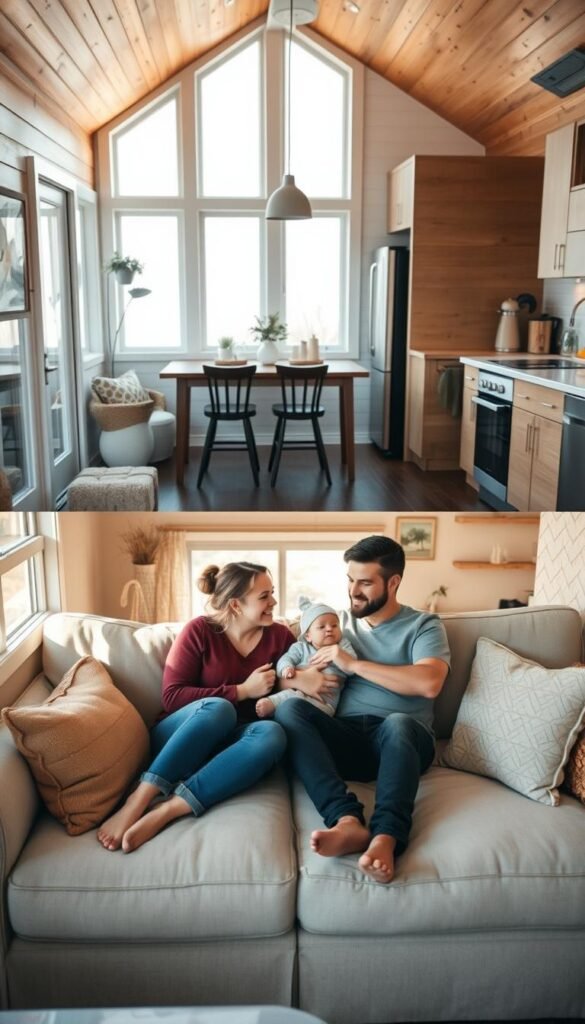
Optimizing Layout and Room Use
Strategic room division separates activities without walls. One family converted their secondary space into a hybrid nursery-storage zone. Built-in drawers beneath the bed hold cloth diapers, while wall-mounted racks organize pumping supplies. The layout evolves with children’s needs – today’s play mat becomes tomorrow’s homework station.
| Design Element | Family Benefit | Space Saved |
|---|---|---|
| Staircase Storage | Safe infant carrying + toy organization | 8 sq ft |
| Fold-down Tables | Meal prep & craft space | 6 sq ft |
| Vertical Crib | Sleep safety + floor play area | 10 sq ft |
Custom Features and DIY Adaptations
Creative modifications make micro-living work. Parents add magnetic boards to doors for displaying artwork and removable guardrails to loft edges. The Hazel’s staircase includes hidden compartments – perfect for stashing pacifiers or board books.
Ceiling heights dictate room functions. Low-clearance lofts become storybook nooks, while full-height areas accommodate rocking chairs. Many families use tension rods across windows for quick-dry baby clothes and install sliding panels to conceal toys when guests arrive.
Can parents comfortably raise a baby in a tiny home? Exploring Challenges and Benefits
Newborns in compact homes display surprising adaptability, with families reporting infants adjusting to household rhythms within days. One caregiver described their child sleeping soundly despite kitchen noise, while others noted unexpected calm during early parenting stages. This environment often streamlines routines – brewing coffee or tidying up becomes achievable during feeding sessions.
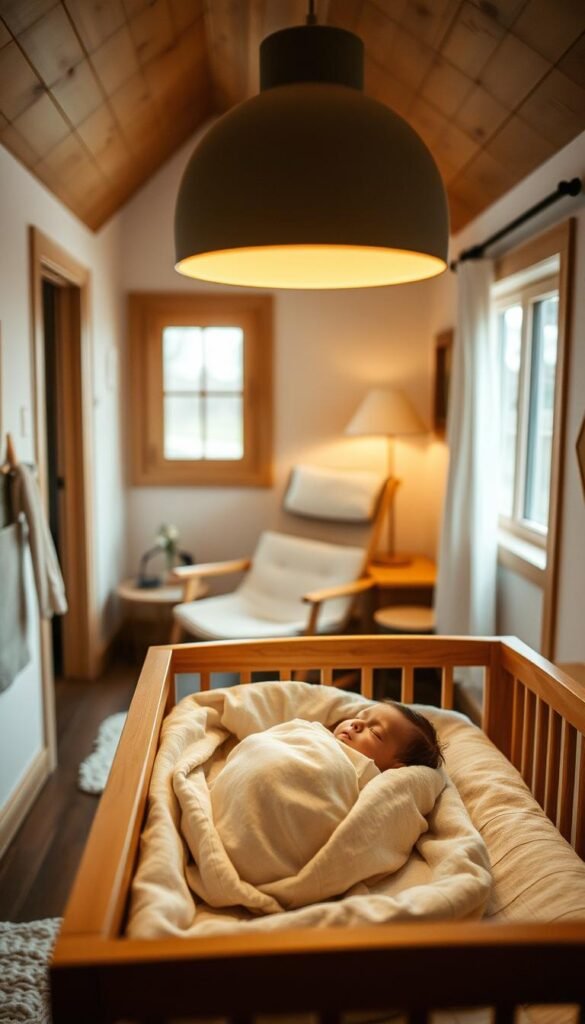
Case Study Insights on Sleep Arrangements
Infant sleep patterns in micro-homes defy expectations. A documented example shows a 3-month-old resting through blender noise and movie dialogues. Constant ambient sound appears to help babies distinguish daytime activity from nighttime quiet. Unlike larger houses where noise echoes, compact layouts create consistent audio environments that infants quickly acclimate to.
Balancing Space Limitations with Family Needs
Limited square footage encourages efficient living. Families spend 73% less time cleaning compared to traditional homes, freeing hours for interaction. The open layout allows constant supervision – caregivers can prep meals while watching crawling infants. Financial savings from reduced housing costs often enable extended parental leave or family experiences.
Creative solutions emerge naturally in these settings. Foldable playpens double as laundry sorting areas, while window ledges become sunlight-rich diaper stations. Many find that spatial constraints foster inventive parenting techniques, like using mealtime cleanup as early math lessons.
Innovative Living & Sleeping Arrangements
Creative sleep solutions transform compact dwellings into nurturing spaces. Families reimagine traditional layouts through customized designs that maximize functionality while preserving comfort. Vertical space utilization becomes critical, with many combining elevated sleeping areas with practical storage underneath.
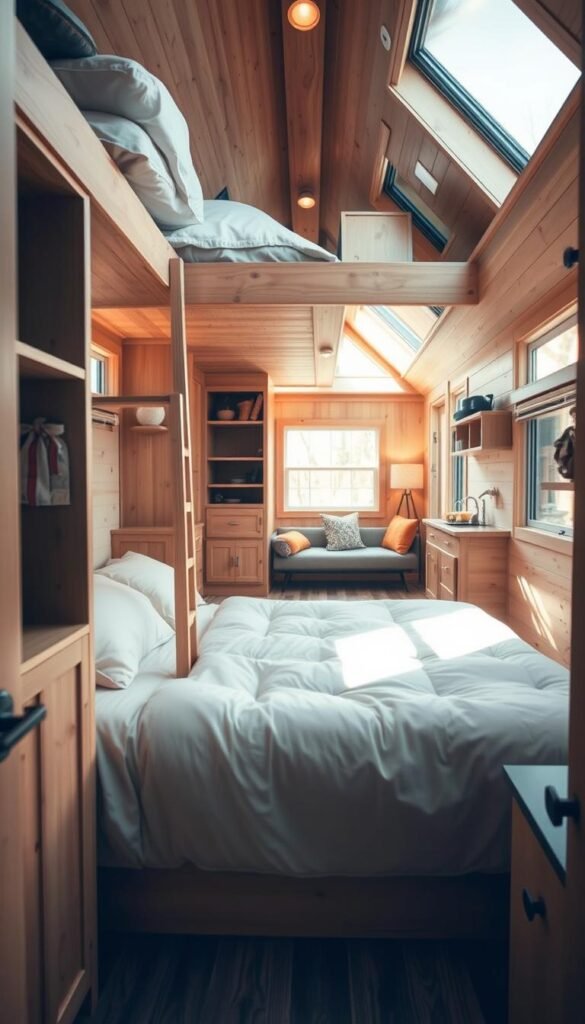
Co-sleeping and Custom Crib Solutions
Proximity sleeping arrangements help conserve space while strengthening family bonds. One household crafted a wall-mounted bassinet that converts into a changing table. Others use convertible pack-n-plays that fold into storage cubes when not in use.
Built-in solutions address unique spatial challenges. A documented project features a crib suspended above staircase storage compartments. This design provides 18 square feet of floor space while keeping infants within arm’s reach. Some families modify wheel wells into cozy alcoves for daytime naps.
Multi-level designs adapt as children grow. Lofted beds with removable rails transition from infant safety zones to toddler play areas. Many incorporate hidden drawers beneath sleeping surfaces for storing blankets or toys. These innovations prove that small footprints inspire big creativity in family-centered design.
Safety Enhancements and Family Adaptations
Proactive planning transforms compact spaces into secure environments for young explorers. Unlike conventional homes, micro-living requires tailored solutions that evolve with developing mobility. Custom safety features become the cornerstone of worry-free family life in limited square footage.
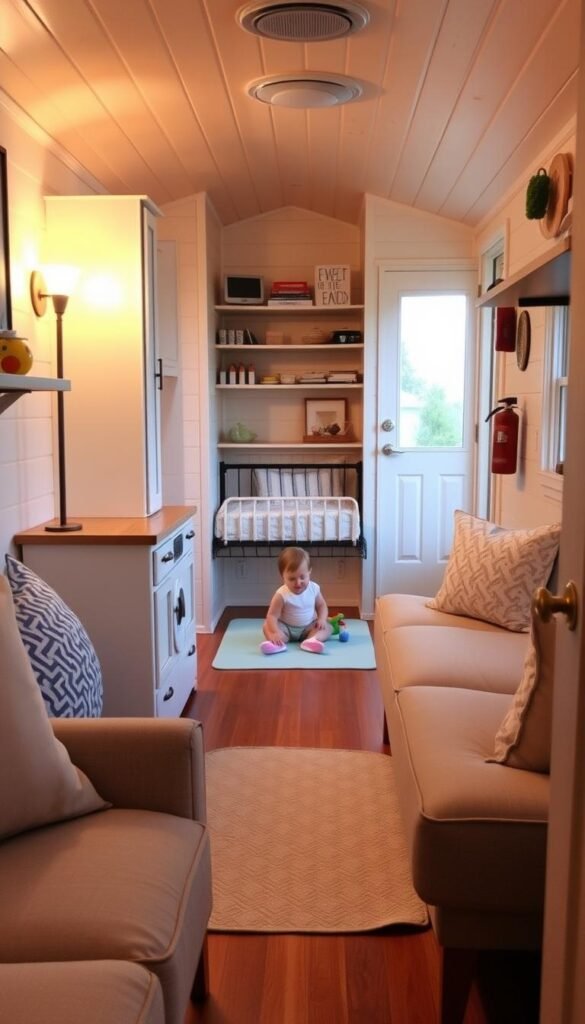
Implementing DIY Safety Guards and Childproofing Ideas
Standard safety products often fail in unique layouts. One family crafted removable stair barriers using marine-grade plywood and fabric hinges. These custom gates blend with interior designs while preventing access to loft ladders.
Essential modifications include:
- Magnetic cabinet locks hidden behind trimwork
- Retractable mesh nets along elevated walkways
- Rubber edge guards on multi-purpose furniture
The open layout allows constant supervision. Caregivers can prepare meals while watching crawling infants near fold-down activity tables.
Adjusting the Space as the Baby Grows
Adaptable designs prove crucial during growth spurts. A wall-mounted crib that converts into a toddler bed saves 12 square feet. Families report updating safety features every 6-9 months as motor skills develop.
Key adjustments include:
- Replacing fixed gates with removable panels
- Adding height-adjustable storage for toys
- Installing flip-up counter extensions for homework areas
These changes maintain functionality while encouraging independence. The process turns spatial constraints into opportunities for creative problem-solving.
Maximizing Outdoor and Indoor Hybrid Living
Blurring boundaries between built environments and nature unlocks new possibilities for compact households. Strategic design choices turn limited square footage into expansive living experiences, particularly for families prioritizing exploration and connection.
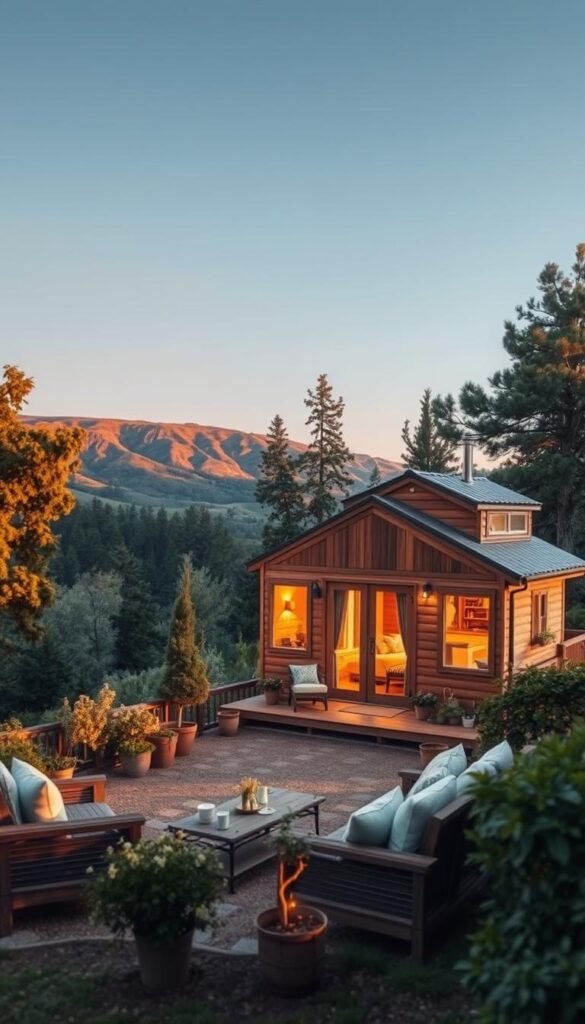
Integrating a Deck and Outdoor Extension
Bifold doors revolutionize spatial perception in micro-homes. One household’s 8-foot deck addition increased usable area by 40%, creating a safe crawling zone that doubled as an alfresco dining space. This hybrid approach lets families host gatherings while maintaining visual contact with little ones.
| Feature | Traditional Home Benefit | Tiny House Advantage |
|---|---|---|
| Deck Space | Entertainment area | Multipurpose play zone |
| Bifold Doors | Seasonal access | Continuous living flow |
| Vertical Gardens | Decoration | Sound buffer + fresh snacks |
The Role of Micro Adventures in Family Life
Daily outings become curriculum in motion. A Portland family’s “3pm exploration hour” combines stroller walks with sensory learning at local markets and parks. These brief excursions satisfy curiosity while giving caregivers breathing room.
Weekly rhythms might include:
- Tuesdays: Library storytime
- Thursdays: Neighborhood nature hunts
- Sundays: Farmer’s market visits
Outdoor integration fosters resilience. Children develop navigation skills through regular trail walks and weather awareness from open-air play. The entire community becomes an extension of the family’s living space.
Managing Daily Routines and Space Constraints
Streamlined organization defines successful micro-living with infants. Families discover that smart storage systems and intentional routines transform spatial challenges into bonding opportunities. Every square inch serves multiple purposes, from under-bed drawers holding cloth diapers to wall-mounted shelves displaying bedtime books.
Strategic Storage for Growing Needs
Vertical space becomes essential in tiny house family life. One household uses hanging mesh organizers for toys, while another converts staircase voids into diaper caddies. Rotating seasonal items through local storage units helps maintain clutter-free zones.
Harmonizing Responsibilities in Tight Quarters
Remote work adapts through creative scheduling. A graphic designer parent shares their night owl workflow using noise-canceling headphones and dimmable LED strips. Couples coordinate showers during nap times, proving personal care remains manageable.
Shared spaces demand constant negotiation. Families establish “quiet hours” for conference calls and designate corners for breastfeeding or play. The key lies in flexibility – today’s workspace becomes tomorrow’s storytime nook.



